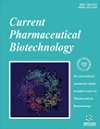- Home
- A-Z Publications
- Current Pharmaceutical Biotechnology
- Previous Issues
- Volume 25, Issue 16, 2024
Current Pharmaceutical Biotechnology - Volume 25, Issue 16, 2024
Volume 25, Issue 16, 2024
-
-
Unconventional Remedies for Squamous Cell Carcinoma: A Journey into Alternative Treatments
More LessAuthors: Elen Deng and Amor KhachemouneSquamous cell carcinoma (SCC) is the second most common form of skin cancer and is typically found on sun-exposed skin. Risk factors include ultraviolet radiation exposure, older age, fairer complexion, smoking, and immunosuppression. SCC is a slow-growing tumor with the possibility of metastasis if not treated. The clinical presentation can range from a dry, scaly erythematous patch or plaque to a firm hyperkeratotic p Read More
-
-
-
Recent Advances in Pharmaceutical Design: Unleashing the Potential of Novel Therapeutics
More LessPharmaceutical design has made significant advancements in recent years, leading to the development of novel therapeutics with unprecedented efficacy and safety profiles. This review highlights the potential of these innovations to revolutionize healthcare and improve patient outcomes. The application of cutting-edge technologies like artificial intelligence, machine learning, and data mining in drug discovery and design has m Read More
-
-
-
Overcoming Low Adherence to Chronic Medications by Improving their Effectiveness using a Personalized Second-generation Digital System
More LessAuthors: Areej Bayatra, Rima Nasserat and Yaron IlanIntroduction: Low adherence to chronic treatment regimens is a significant barrier to improving clinical outcomes in patients with chronic diseases. Low adherence is a result of multiple factors. Methods: We review the relevant studies on the prevalence of low adherence and present some potential solutions. Results: This review presents studies on the current measures taken to overcome low adherence, indicating a need f Read More
-
-
-
The Gut Microbiota and Major Depressive Disorder: Current Understanding and Novel Therapeutic Strategies
More LessMajor depressive disorder (MDD) is a common neuropsychiatric challenge that primarily targets young females. MDD as a global disorder has a multifactorial etiology related to the environment and genetic background. A balanced gut microbiota is one of the most important environmental factors involved in human physiological health. The interaction of gut microbiota components and metabolic products with the hypothal Read More
-
-
-
Naringenin Nanoformulations for Neurodegenerative Diseases
More LessAuthors: Liza Sahoo, Nigam S. Tripathy and Fahima DilnawazGlioblastoma (GBM) is a grade-IV astrocytoma, which is the most common and aggressive type of brain tumor, spreads rapidly and has a life-threatening catastrophic effect. GBM mostly occurs in adults with an average survival time of 15 to 18 months, and the overall mortality rate is 5%. Significant invasion and drug resistance activity cause the poor diagnosis of GBM. Naringenin (NRG) is a plant secondary metabolite bypr Read More
-
-
-
RNA-based Therapeutics: Past, Present and Future Prospects, Challenges in Cancer Treatment
More LessAuthors: Anjana Goel, Amisha Rastogi, Mansi Jain and Kinjal NiveriyaIt is becoming more and harder in today's climate to disregard the impact of cancer on social health. Even though a significant amount of money is spent annually on cancer research, it still ranks as the second leading cause of death worldwide. Additionally, only about half of the patients suffering from complex forms of cancer survive a year after receiving traditional cancer therapies. A method for silencing genes is calle Read More
-
-
-
Effects and Mechanisms of Fisetin against Ischemia-reperfusion Injuries: A Systematic Review
More LessBackground: Ischemia-reperfusion injury (IRI) is a well-known ailment that can disturb organ function. Objectives: This systematic review study investigated fisetin's effects and possible mechanisms in attenuating myocardial, cerebral, renal, and hepatic IRIs. Methods: This systematic review included studies earlier than Sep 2023 by following the PRISMA statement 2020. After determining inclusion and exclusion criteria and re Read More
-
-
-
Quassinoids from Eurycoma longifolia as Potential Dihydrofolate Reductase Inhibitors: A Computational Study
More LessBackground: Quassinoids are degraded triterpene compounds that can be obtained from various species of the Simaroubaceae plant family, including Eurycoma longifolia. Quassinoids are the major compounds in E. longifolia, and they are known to have various medicinal potentials, such as anticancer and antimalarial properties. Dihydrofolate reductase (DHFR) was reported to be one of the important targets for certain a Read More
-
-
-
Long Non-coding RNA DLEU1 Promotes Progression of Osteoarthritis via miR-492/TLR8 Axis
More LessAuthors: Chenzhe Ni, Wanglin Zhang, Sai Qiu, Hao Cheng and Chunhui MaBackground: Long non-coding RNAs (LncRNAs) are generally reported to participate in the development of Osteoarthritis (OA) by acting as competing endogenous RNAs (ceRNAs). However, the molecular mechanism is largely unknown. This study aimed to investigate the possible mechanisms contributing to osteoarthritis (OA). Methods: Four gene expression profiles from patients with OA were downloaded from a Read More
-
Volumes & issues
-
Volume 26 (2025)
-
Volume 25 (2024)
-
Volume 24 (2023)
-
Volume 23 (2022)
-
Volume 22 (2021)
-
Volume 21 (2020)
-
Volume 20 (2019)
-
Volume 19 (2018)
-
Volume 18 (2017)
-
Volume 17 (2016)
-
Volume 16 (2015)
-
Volume 15 (2014)
-
Volume 14 (2013)
-
Volume 13 (2012)
-
Volume 12 (2011)
-
Volume 11 (2010)
-
Volume 10 (2009)
-
Volume 9 (2008)
-
Volume 8 (2007)
-
Volume 7 (2006)
-
Volume 6 (2005)
-
Volume 5 (2004)
-
Volume 4 (2003)
-
Volume 3 (2002)
-
Volume 2 (2001)
-
Volume 1 (2000)
Most Read This Month
Article
content/journals/cpb
Journal
10
5
false
en


